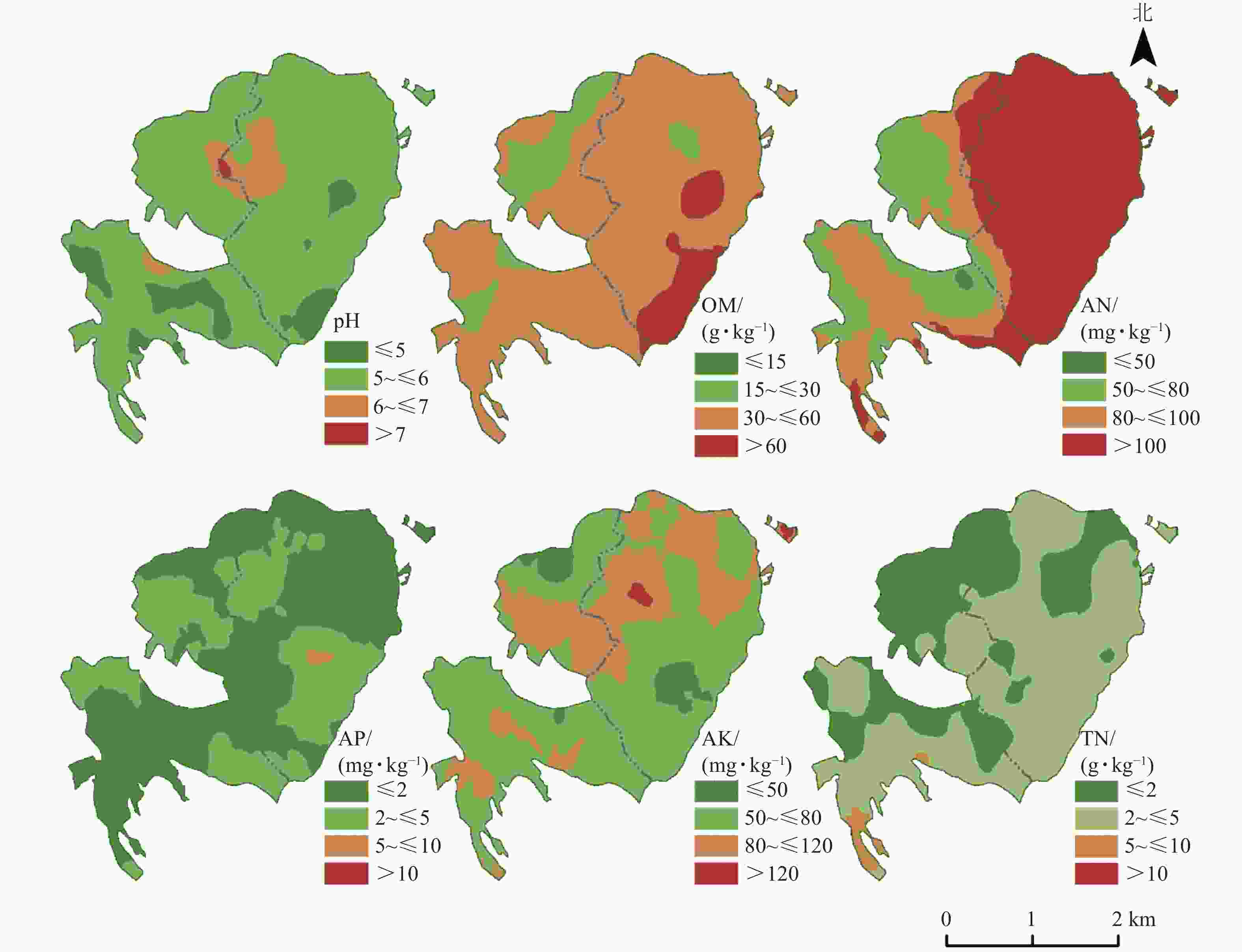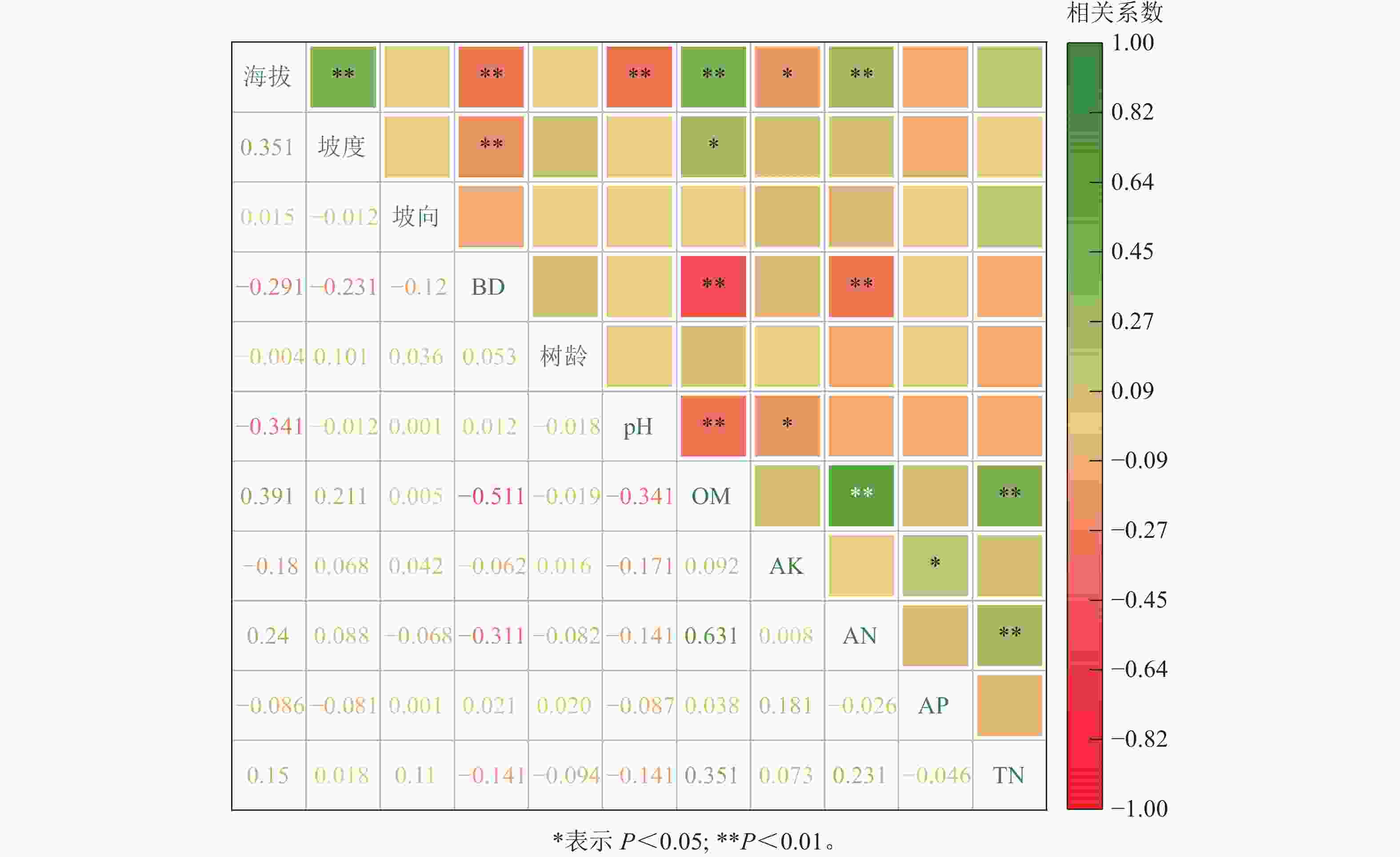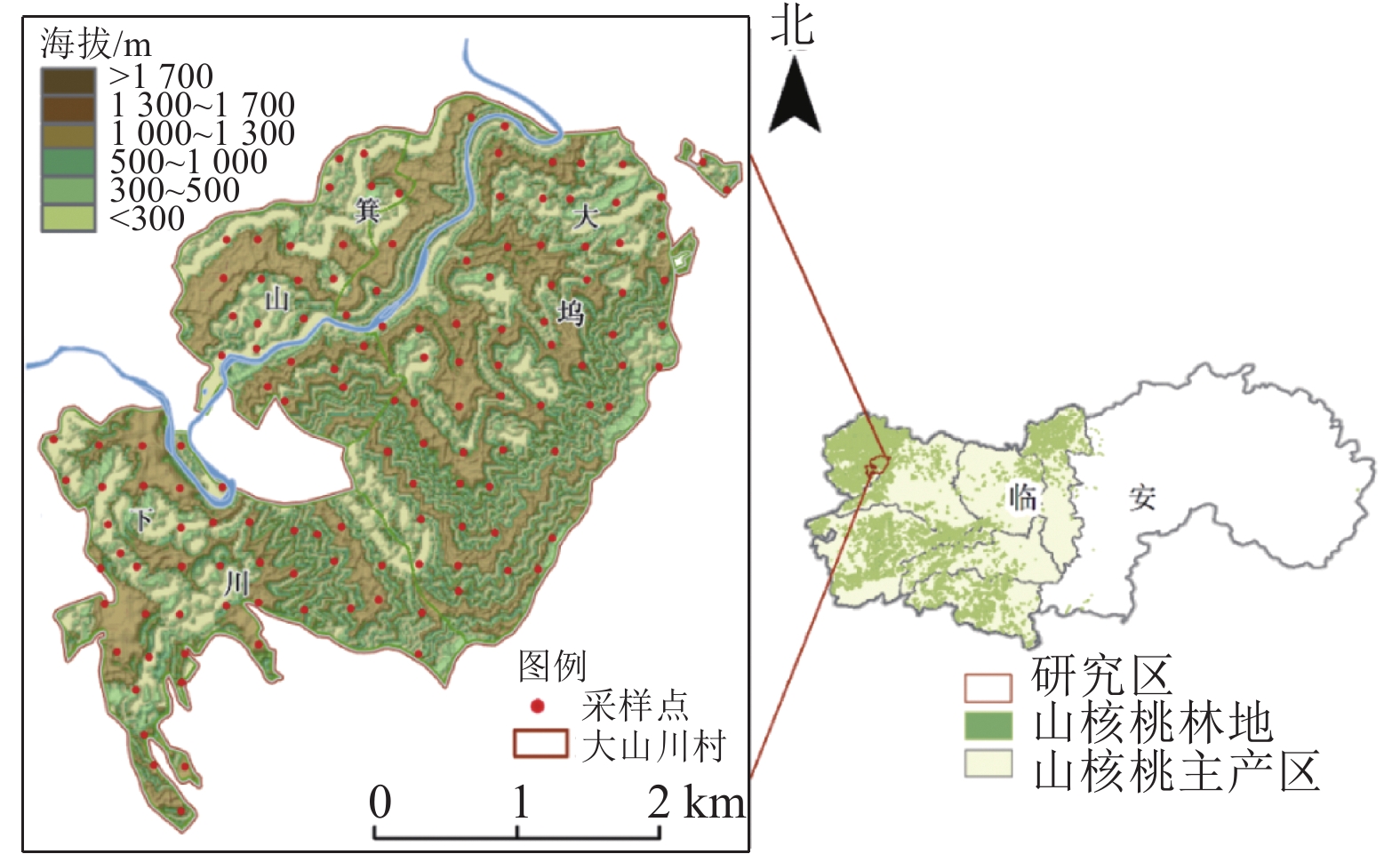-
山核桃Carya cathayensis是中国特有的优质干果和木本油料经济树种,果实风味独特,营养价值高,是世界四大名优坚果之一[1]。主要分布在浙皖交界的天目山区,以浙江省杭州市临安区种植面积最大,约6×104 hm2,其产量占全国总产量的60%以上,其产值收入可占当地林农总收入的70%以上,是山区林农致富的主要经济来源[2]。然而,为了追求更高的产量,林农们在缺乏对土壤肥力现状认识的基础上盲目施用大量化肥、除草剂,从而导致了土壤酸化、营养失衡、植株生长异常甚至连片死亡等现象[3],对山核桃产业可持续经营带来了严重威胁。鉴于此,客观掌握和评价土壤肥力状况,研究土壤肥力变异规律及其影响因素,为山核桃林地测土配方施肥、提高生产力和精准农业发展具有重要现实意义。
国内外学者对土壤的异质性进行了大量的研究,CAMBARDELLA等[4]证明了地统计学与地理信息系统(GIS)相结合对深入揭示土壤养分空间异质性及影响因素最为有效。不同时空尺度下,土壤养分的变异规律不尽相同,中大尺度下土壤性质空间异质性易受到地形、气候、土壤类型等区域因素的影响[5−8],而小尺度下土壤肥力分异特征易受土壤质地、微地形、人为经营方式等影响[9]。
关于山核桃林地土壤养分空间异质性的研究[2, 10]基于尺度较大、采样间距较大,获得的土壤信息往往掩盖了小尺度下土壤特性的空间变异特征,降低了影响因素的代表性,难以精准指导村域尺度的土壤管理[11]。本研究选取浙江省杭州市临安区岛石镇典型的山核桃主产区——大山川村为对象,采用地统计学与GIS相结合的方法探究大山川村山核桃林地土壤肥力变化规律和分布格局,并分析土壤肥力指标之间的相关性,评价土壤肥力水平,探明影响土壤肥力的主控因子,以期为小尺度山核桃林地生态化经营及合理培肥提供科学依据。
-
大山川村(30°16′N,118°58′E)位于浙江省杭州市临安区西北部,包含大坞、箕山、下川等3个自然村。地貌类型以山地为主,气候属亚热带季风气候,年均气温为16.7 ℃,年均日照时长为1 847.3 h,年均降水量为1 628.0 mm,四季分明,雨量充沛,雨热同季,光热水资源良好。成土母质以钙质泥页岩类风化物为主,土壤类型为岩性土。山核桃面积为590 hm2,分布在海拔为50~1 200 m的山地。山核桃产业是全村的主导产业,2021年人均山核桃收入达31 169元[12]。
-
在研究区以250 m×250 m网格预设土壤采样点,在实际采样过程中结合山核桃林地实际分布状况,按照预设样点附近20 m内调整原则,利用全球定位系统(GPS)准确定位并记录实际采样点的坐标,于2021年7月采集有效的土壤(0~30 cm土层)样品共134个(图1)。同时记录采样点的立地条件、农户经营管理措施等信息。
土壤容重(BD)采用环刀法测定;土壤经去杂、风干、研磨过2.000 mm筛后,采用酸度计测定pH;土壤碱解氮(AN)、有效磷(AP)、速效钾(AK)分别用碱解扩散法、碳酸氢钠浸提-钼锑抗比色法和醋酸铵浸提-火焰光度法测定。土壤过0.149 mm筛后,有机质(OM)和全氮(TN)分别采用重络酸钾氧化还原滴定法和半微量凯氏法测定[13]。
-
地统计学以反映区域化现象的随机函数——半方差函数(semi-variogram)为基础,分析变量的各种空间变异与结构,并为空间预测提供基础[14]。块金值($ {C}_{0} $)、基台值($ {C}_{0}+C $)和变程是半方差函数的3个重要参数。块金值代表由采样误差和分析等随机因素引起的非连续变异;基台值表示由样本数据的空间相关性而引起的总变异范围;变程代表样点的空间自相关距离尺度并描述了在该尺度内空间相关特征,即在该尺度之内,空间距离越近则相关性越强。实际应用中,块基比$ {C}_{0} $/($ {C}_{0}+C $)表示由随机因素(施肥措施、耕作方式等)引起的空间变异程度。CAMBARDELLA等[4]将块基比分为3类:<25.00%、25.00%~75.00%和>75.00%分别代表强、中、弱的空间变异程度,比值越高代表由随机因素引起的空间变异性越强。基于半方差函数拟合的最优模型,克里金插值法可预测和总结土壤特征并绘制成图[14],
-
按照主导性、生产性、均匀性和稳定性的选取原则[15],结合前人的研究[2],选取pH、BD、OM、AN、AP、AK、TN等7项肥力评价指标建立评价指标体系。作物效应曲线将隶属度函数分为“S”型和抛物线型,并将曲线型函数转化为相应的折线型利于计算[15]。属于抛物线型函数的指标有pH和BD,其余5种指标均属于“S”型。参考《浙江林业土壤》[16]养分分级标准,在掌握大山川村山核桃林地土壤肥力指标的基础上,确定各指标转折点的取值: pH为4.5、6.5、7.5和8.5;BD为0.9、1.1、1.3和1.5 g·cm−3;OM为10.0和50.0 g·kg−1;AN为50.0和150.0 mg·kg−1;AP为2.5和10.0 g·kg−1;AK为50.0和100.0 mg·kg−1;TN为0.5和1.2 g·kg−1。采用相关系数法确定各指标对土壤肥力的贡献度[17]确定权重系数(表1)。
表 1 土壤肥力指标的平均相关系数和权重系数
Table 1. Average correlation coefficients and weight value of soil fertility indexes
指标 相关系数平均值 权重系数 pH 0.16 0.13 BD 0.19 0.15 OM 0.33 0.27 AN 0.23 0.19 AP 0.07 0.05 AK 0.09 0.08 TN 0.16 0.13 基于模糊数学中的加乘法则,利用各指标的隶属度值和权重系数计算土壤综合肥力指数(IFI) [17]。IFI取值为0~1,该值越接近于1,表示土壤肥力越高。根据山核桃林地土壤肥力实际情况并结合等距法[18]将IFI分为5级(表2)。
表 2 土壤肥力水平分级标准及各等级所占比例
Table 2. Classification standard of soil fertility and its proportion
等级 IFI 各等级比例/% 肥力水平 Ⅴ ≤0.40 2.99 差 Ⅳ (0.40~0.60] 23.88 较差 Ⅲ (0.60~0.70] 33.58 中等 Ⅱ (0.70~0.80] 20.15 良好 Ⅰ >0.80 19.40 优秀 -
采用Excel 2016和SPSS 26.0整理和分析数据,用Kolmogorov-Smirnov (K-S)进行正态性检验(BD、AN服从正态分布,pH、OM、AK和AP分别经对数、Box-Cox转换后均符合正态分布,满足地统计分析条件)。利用GS+9.0进行半方差分析,依据决定系数(R2)越大,残差平方和(RSS)越小的原则拟合理论模型[7]。采用ArcGIS 10.2绘制土壤肥力各指标空间分布图,利用Origin 2021分析土壤肥力指标间Pearson相关性并绘图。采用主成分分析法分析肥力因子与土壤肥力之间的载荷情况[17]。
-
如表3所示:研究区林地土壤pH值变幅为4.60~8.24,平均值为5.39。BD均值为1.14 g·cm−3。OM、TN质量分数均值分别为42.13,2.33 g·kg−1,AN、AP和AK质量分数均值分别为115.89、1.47、82.69 mg·kg−1。可见,OM、AN、AK和TN处于中等偏上水平,其中有72.3%的区域OM达四级标准(>30.0 g·kg−1,四级最高,一级最低);与之相反,AP水平普遍较低,其中有97.0%的区域AP质量分数低于5.0 mg·kg−1。山核桃林地土壤养分变异系数范围为10.25%~151.21%。pH、BD、OM、TN、AN和AK均为中度变异(10.00%~90.00%),从大到小依次为TN、AK、OM、AN、BD、pH。AP表现为高度变异(>90.00%),变异系数最大(151.21%)。
表 3 山核桃林地土壤肥力指标描述性统计
Table 3. Descriptive statistics of soil fertility properties in Chinese hickory plantation
项目 pH BD/(g·cm−3) OM/(g·kg−1) TN/(g·kg−1) AN/(mg·kg−1) AP/(mg·kg−1) AK/(mg·kg−1) 均值 5.39 1.14 42.13 2.33 115.89 1.47 82.69 最小值 4.60 0.58 10.51 0.32 1.39 0.03 10.04 最大值 8.24 1.70 153.11 12.31 311.57 16.94 273.72 标准差 0.55 0.16 22.22 1.58 57.73 2.23 46.26 变异系数/% 10.25 14.04 52.75 67.62 49.82 151.21 55.94 偏度 2.215(1.67) −0.110 2.262(0.22) 3.753(0.12) 0.670 3.515(0.01) 1.671(−0.33) 峰度 7.330(4.48) 1.800 7.226(0.89) 19.613(2.84) 1.070 17.839(−0.03) 3.709(1.18) K-S 0.024(0.07) 0.129 0.003(0.68) 0.000(0.07) 0.448 0.000(0.20) 0.004(0.64) 说明:括号内分别为经对数、Box-Cox转换后的偏度、峰度和K-S检验的显著性水平;n=134。 -
土壤pH、AP和AK均符合球状模型(表4),BD和AN、OM和TN分别符合指数模型和高斯模型。pH、BD、OM、TN、AP和AK块金值接近于0,而AN块金值较大。从块基比来看,BD、TN、AP和AK的块基比均小于25.00% (0~7.00%),表明具有强烈的空间相关性;土壤pH、OM的块基比为25.00%~75.00%,属于中等强度的空间相关性;而土壤AN块基比>75.00%,呈现弱空间相关性,说明其变异主要受到经营活动等随机因素的影响。OM的变程最大,为2 364 m,表明空间分布的连续性较强。pH、BD、TN、AN、AP和AK的变程较小,分别为732、390、327、1 951、342和272 m。变程均超过了采样间距,表明采样设计具有代表性。
表 4 山核桃林地土壤肥力指标半方差函数理论模型及其相关参数
Table 4. Semi-variogram model and parameters of soil fertility properties in Chinese hickory plantation
指标 理论模型 块金值$ \left({C}_{0}\right) $ 基台值$ {(C}_{0}+C) $ 变程/m 块基比$ [{C}_{0} $/($ {C}_{0}+C $)]/% R2 pH 球状模型 0.000 5 0.001 8 732 27.78 0.98 BD 指数模型 0.001 6 0.025 3 390 6.32 0.83 OM 高斯模型 0.029 5 0.067 9 2 364 43.44 0.83 TN 高斯模型 0.002 3 0.045 9 327 5.01 0.86 AN 指数模型 2 798.202 6 3 432.030 4 1 951 81.27 0.63 AP 球状模型 0.013 0 1.447 0 342 0.90 0.94 AK 球状模型 0.004 0 0.057 2 272 7.00 0.80 -
如图2所示:大部分地区土壤pH 5~6和6~8的土壤集中在中部;OM和AN的空间分布规律相似,从西北部向东南部逐渐升高,其中东部AN空间同质化现象显著,斑块较大。AP质量分数整体较低。AK的空间分布特征为中间向两侧逐渐降低。TN质量分数整体适中,空间分布规律西低东高,有52.2%的土壤TN质量分数远大于全国第2次土壤普查一级标准(>2 g·kg−1)[19]。
-
地形因子与土壤肥力指标间的相关性表明(图3):海拔与pH、BD、OM、AK和AN显著相关(P<0.05),其中与OM、AN呈极显著的正相关(P<0.01),表明OM、AN的质量分数随着海拔的升高而增加;而与pH、BD、AK呈显著的负相关(P<0.05),其中与pH的负相关系数最大。BD与OM、AN呈极显著的负相关(P<0.01),表明BD密切影响着土壤肥力水平。
土壤肥力指标之间的相关性(图3)显示:pH与其他土壤养分呈负相关,其中与OM呈极显著负相关(P<0.01),与AK呈显著负相关(P<0.05);OM、AN、TN两两之间呈极显著正相关(P<0.01)。
-
基于模糊综合评价法评估,研究区土壤综合肥力指数为0.20~0.90,平均为0.66,可见土壤肥力水平适中。如图4所示:肥力指数较高的土壤以斑块状主要分布在中部,分布较连贯;大部分区域土壤肥力水平适中;肥力指数较低的土壤分布不均,在西部和东北部均有分布,空间异质性明显。
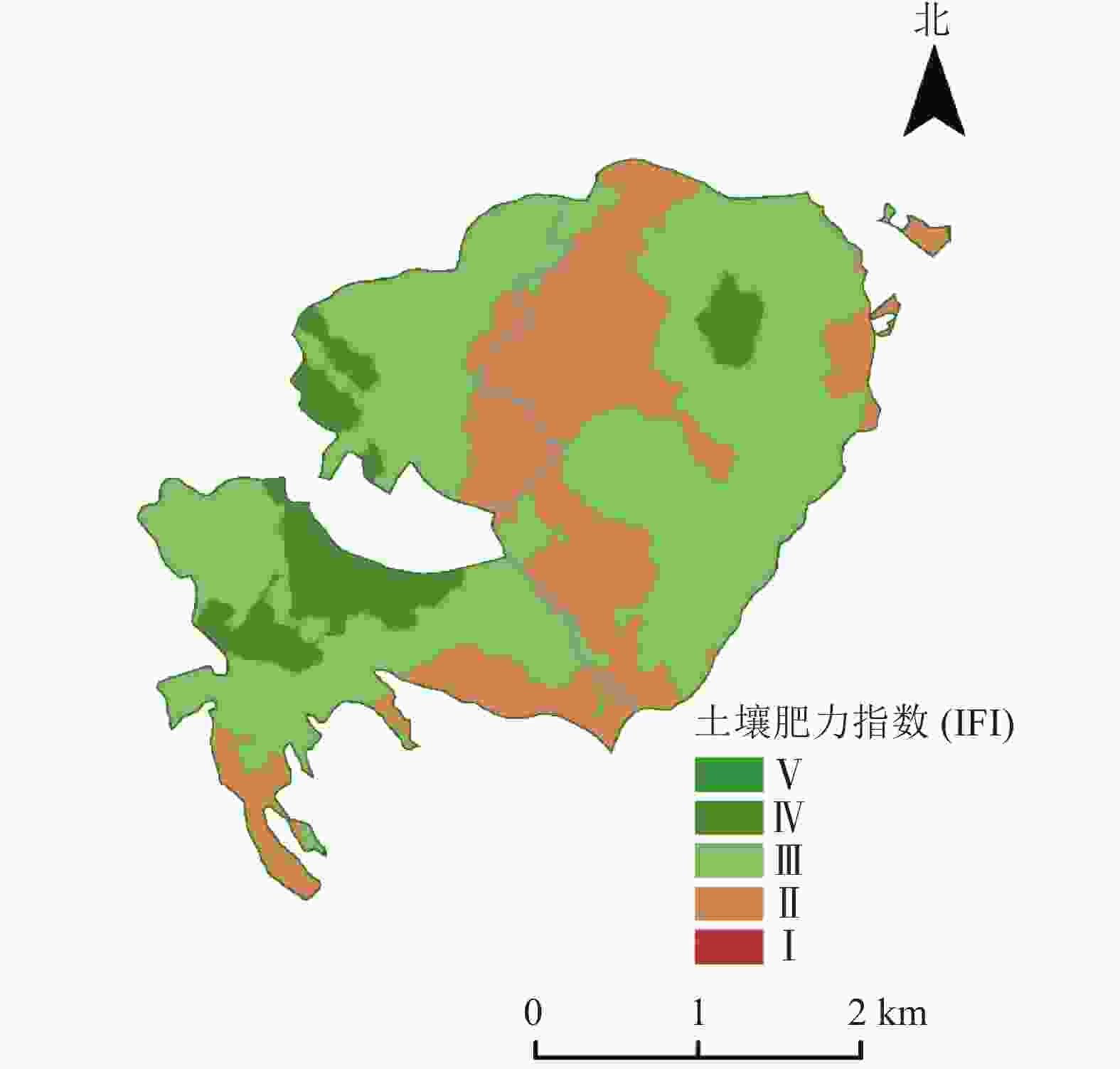
图 4 山核桃林地土壤肥力等级空间分布示意图
Figure 4. Soil fertility level distribution map of Chinese hickory plantation
如表5所示:根据特征值大于1的原则共提取出3个主成分,累计方差贡献率为71.026%。表明利用前3个主成分探究大山川村土壤肥力影响因素可行。土壤综合肥力指数与OM、AN在第1主成分(PC1)上具有较大载荷,均大于0.8,对土壤肥力有显著影响;第2主成分(PC2)AP和AK载荷较大,表征土壤对山核桃速效养分的供给能力;第3主成分(PC3)TN载荷最大。
表 5 土壤各肥力指标的主成分分析
Table 5. Principal component analysis of soil fertility properties
主成分 载荷值 特征根 方差贡献率/% 累计方差贡献率/% pH BD OM AN AP AK TN PC1 0.567 −0.782 0.925 0.838 0.036 0.045 0.383 2.641 37.735 37.735 PC2 0.186 0.156 0.018 0.019 0.790 0.722 −0.201 1.246 17.805 55.540 PC3 0.406 0.237 −0.025 0.188 −0.260 0.526 0.695 1.084 15.487 71.026 -
山核桃最适生长的土壤pH为微酸性及以上(pH 6.00~7.00),土壤酸化现已成为引起山核桃果实品质劣、产量低及林地退化的重要障碍因子[10]。本研究中土壤pH均值为5.39,有90.9%的林地土壤pH<6.00。土壤pH块基比为26.33%,其变异受到结构(土壤母质、地形等)和随机因素(人为扰动、经营措施等)的共同影响。研究区地处最早开始山核桃集约经营的岛石镇,土壤酸化与其长年限的高强度经营措施及过量施肥有关。何萍等[20]也证实了山核桃人工林地土壤pH随着种植年限的增加而降低;TIAN等[21]研究表明:无机氮肥的过量及不当使用是导致全球土壤酸化的主要原因。黄腐酸钾(有机肥)和钙镁磷肥(无机肥)配施不仅能显著降低土壤酸度,提高山核桃林地土壤养分水平,而且能与铝发生络合作用从而降低酸性土壤中铝的毒害[22]。
OM和AN是决定土壤肥力水平的重要指标。本研究中OM、AN质量分数均较高,空间分布规律相似,OM受结构性和随机性因素的共同影响,AN则受随机因素的影响更大。但过高的氮量不利于山核桃的生长发育与果实品质的提高,易诱发山核桃干腐病,且化肥氮素易损失将直接导致地表水面源污染,进而危及人类健康[23]。因研究区林农施用复合肥的用量远大于有机肥,其中研究区东部更加集约化的管理模式降低了土壤AN的变异性,减弱了空间依赖性,使AN的空间分布趋于同质化[17]。AP、AK的块基比分别为0.90%、7.00%,呈强烈的空间自相关,原因是受到结构性因素的影响。其中AP质量分数偏低而变异系数最高(151.21%),这一现象在浙江其他经济林土壤研究中也常见[24]。这主要由于研究区土壤大多为岩性土,土壤中碳酸钙易与磷形成磷酸二钙、磷酸八钙以及难溶的磷灰石等磷酸钙盐沉淀,从而降低了磷的有效性[25]。此外,山核桃林地集约化管理导致复合肥的无差别投入,造成低养分地区养分持续不足和高养分地区养分过剩,也在一定程度上放大了结构性因素对土壤速效养分的影响[17]。
地形可通过海拔变化调控水热分布,影响山区土壤不同垂直地带母岩成土过程、土壤机械组成和微生物[26]。本研究所得结论与此相似,海拔与pH、AK呈显著负相关,而与OM、AN极显著正相关,BD与OM、AN显著负相关。在山核桃适生的南方丘陵山区海拔变化较大,随着高度的增加,气候变得更为湿冷,微生物的分解速度减缓和矿化作用减弱,从而使OM质量分数较高;而钾元素易于顺着水流淋溶下渗[27],由此出现与海拔呈显著负相关的特点。BD是反映土壤涵养水源能力的基本物理指标,受人为活动显著影响,与土壤储水能力、松紧度和质量密切相关。BD值越大,表明土壤紧实度高,透气透水性较差;其值越小,表明土壤疏松多孔,质地较好,保水通气能力高,利于植物细根的伸展和发育,进而提高土壤的保肥供肥性能[28]。
-
研究区土壤整体呈酸性,pH均值为5.39。OM、AK、AN、TN质量分数适中,均表现为中等变异,AP质量分数较低且为高度变异。半方差分析表明:AP、AK、TN主要受结构性因素的影响,pH和OM受结构因素和随机因素的共同影响,AN受人为经营因素影响较大。AP、AK和TN的空间异质性明显,斑块特征显著,OM和AN空间分布规律相似,东南部高值区分布连贯。研究区土壤肥力指数均值为0.66,水平适中。主成分分析表明:OM和AN是影响土壤肥力水平的主控因素。OM、AN与海拔、容重相关性达极显著水平,AK仅与海拔相关性达显著水平。
建议适当降低氮肥施用量,并配施生石灰(3 000 kg·hm−2)以改善土壤酸化状况;按照“大配方,小调整”的原则,根据研究区土壤肥力特征,补施尿素、黄腐酸钾、钙镁磷肥或硫酸钾等元素,以补充土壤中含量较小的元素。
Spatial variability and affecting factors of soil fertility in Chinese hickory stands at village scale
-
摘要:
目的 为村级尺度山核桃Carya cathayensis林地合理培肥提供科学依据。 方法 在浙江省岛石镇大山川村山核桃主产区,系统采集土壤(0~30 cm)样品134个,运用地统计学与地理信息系统(GIS)相结合的方法、主成分分析法(PCA)探究林地土壤肥力空间变异结构特征、土壤肥力状况及其主控因素。 结果 山核桃林地土壤pH 5.39,土壤容重为1.14 g·cm−3,有机质、全氮质量分数分别为42.13和2.33 g·kg−1,土壤碱解氮、速效钾、有效磷质量分数均值分别为115.89、82.69、1.47 mg·kg−1;容重、全氮、有效磷和速效钾的块基比均小于25%,具有强烈的空间相关性,结构因素为主导。pH、有机质具有中等空间相关性,碱解氮受随机因素影响较大;相关性分析表明:土壤pH、有机质、速效钾和碱解氮与海拔、容重显著相关(P<0.05);土壤综合肥力指数均值为0.66,肥力水平适中。主成分分析表明:有机质和碱解氮在第1主成分上具有较大载荷。 结论 山核桃林地土壤酸化及养分失衡现象严重,土壤肥力呈中部高四周低的分布格局。有机质、碱解氮是影响土壤肥力水平的主控因子,受海拔、容重影响显著。今后可按照“大配方,小调整”的原则补施生石灰、氮、磷、钾等单一肥料,以改良山核桃林地土壤酸化并提升土壤肥力质量。图4表5参28 Abstract:Objective This study, with an investigation of a total of 134 topsoil samples (0−30 cm) systematically collected from Chinese hickory (Carya cathayensis) plantation in Dashanchuan Village, Daoshi Town, Zhejiang Province, is aimed to provide scientific basis for rational soil fertility management of Chinese hickory plantation at village scale. Method GIS and geostatistics were utilized to reveal the spatial heterogeneity of soil fertility properties, whereas principal component analysis (PCA) was used to explore the main controlling factors affecting the soil fertility. Result Soil in Dashanchuan Village was acidic (pH 5.39) on the whole with the average of bulk density (BD) being 1.14 g·cm−3 while organic matter (OM), available nitrogen (AN), available potassium (AK) and total nitrogen (TN) were moderate with average concentrations of 42.13 g·kg−1, 115.89 mg·kg−1, 82.69 mg·kg−1 and 2.33 g·kg−1 respectively. Available phosphorus (AP) was low with average concentrations of 1.47 mg·kg−1 with the nugget coefficients of BD, TN, AP and AK below 25%, featured with a strong spatial autocorrelation. Soil pH and OM showed moderately spatial autocorrelation. AN fit the weak spatial autocorrelation, which indicated that random factors had a significant influence. The results of correlation analysis revealed that pH, OM, AK and AN had significant correlation with altitude and bulk density (P<0.05) while the integrated fertility index (IFI) of study area ranged from 0.20 to 0.90 with an average of 0.66, indicating moderate fertility level. Principal component analysis showed that OM and AN had a high load in PC1. Conclusion The study area suffered serious the soil acidification and nutrient imbalances with the soil fertility being high in the middle but low in the surrounding areas. Besides, OM and AN, are the main controlling factors affecting soil fertility quality of the study area, with their contents significantly affected by elevation and BD. Therefore, to improve soil acidification and soil fertility quality so as to better manage the soil, single element fertilizers including quicklime, nitrogen, phosphorus and potassium could be applied under the principle of “large formula, small adjustment” based on formula fertilizer. [Ch, 4 fig. 5 tab. 28 ref.] -
Key words:
- Chinese hickory /
- village scale /
- geostatistics /
- principal component analysis /
- spatial varibility /
- soil
-
表 1 土壤肥力指标的平均相关系数和权重系数
Table 1. Average correlation coefficients and weight value of soil fertility indexes
指标 相关系数平均值 权重系数 pH 0.16 0.13 BD 0.19 0.15 OM 0.33 0.27 AN 0.23 0.19 AP 0.07 0.05 AK 0.09 0.08 TN 0.16 0.13 表 2 土壤肥力水平分级标准及各等级所占比例
Table 2. Classification standard of soil fertility and its proportion
等级 IFI 各等级比例/% 肥力水平 Ⅴ ≤0.40 2.99 差 Ⅳ (0.40~0.60] 23.88 较差 Ⅲ (0.60~0.70] 33.58 中等 Ⅱ (0.70~0.80] 20.15 良好 Ⅰ >0.80 19.40 优秀 表 3 山核桃林地土壤肥力指标描述性统计
Table 3. Descriptive statistics of soil fertility properties in Chinese hickory plantation
项目 pH BD/(g·cm−3) OM/(g·kg−1) TN/(g·kg−1) AN/(mg·kg−1) AP/(mg·kg−1) AK/(mg·kg−1) 均值 5.39 1.14 42.13 2.33 115.89 1.47 82.69 最小值 4.60 0.58 10.51 0.32 1.39 0.03 10.04 最大值 8.24 1.70 153.11 12.31 311.57 16.94 273.72 标准差 0.55 0.16 22.22 1.58 57.73 2.23 46.26 变异系数/% 10.25 14.04 52.75 67.62 49.82 151.21 55.94 偏度 2.215(1.67) −0.110 2.262(0.22) 3.753(0.12) 0.670 3.515(0.01) 1.671(−0.33) 峰度 7.330(4.48) 1.800 7.226(0.89) 19.613(2.84) 1.070 17.839(−0.03) 3.709(1.18) K-S 0.024(0.07) 0.129 0.003(0.68) 0.000(0.07) 0.448 0.000(0.20) 0.004(0.64) 说明:括号内分别为经对数、Box-Cox转换后的偏度、峰度和K-S检验的显著性水平;n=134。 表 4 山核桃林地土壤肥力指标半方差函数理论模型及其相关参数
Table 4. Semi-variogram model and parameters of soil fertility properties in Chinese hickory plantation
指标 理论模型 块金值$ \left({C}_{0}\right) $ 基台值$ {(C}_{0}+C) $ 变程/m 块基比$ [{C}_{0} $/($ {C}_{0}+C $)]/% R2 pH 球状模型 0.000 5 0.001 8 732 27.78 0.98 BD 指数模型 0.001 6 0.025 3 390 6.32 0.83 OM 高斯模型 0.029 5 0.067 9 2 364 43.44 0.83 TN 高斯模型 0.002 3 0.045 9 327 5.01 0.86 AN 指数模型 2 798.202 6 3 432.030 4 1 951 81.27 0.63 AP 球状模型 0.013 0 1.447 0 342 0.90 0.94 AK 球状模型 0.004 0 0.057 2 272 7.00 0.80 表 5 土壤各肥力指标的主成分分析
Table 5. Principal component analysis of soil fertility properties
主成分 载荷值 特征根 方差贡献率/% 累计方差贡献率/% pH BD OM AN AP AK TN PC1 0.567 −0.782 0.925 0.838 0.036 0.045 0.383 2.641 37.735 37.735 PC2 0.186 0.156 0.018 0.019 0.790 0.722 −0.201 1.246 17.805 55.540 PC3 0.406 0.237 −0.025 0.188 −0.260 0.526 0.695 1.084 15.487 71.026 -
[1] 袁紫倩, 叶正钱, 李皓, 等. 影响山核桃林地土壤生产性能的主要肥力因子及其临界区间[J]. 植物营养与肥料学报, 2020, 26(1): 163 − 171. YUAN Ziqian, YE Zhengqian, LI Hao, et al. Main soil fertility factors and their critical ranges for Chinese walnut (Carya cathayensis Sarg. ) production [J]. Journal of Plant Nutrition and Fertilizers, 2020, 26(1): 163 − 171. [2] 沈一凡, 钱进芳, 郑小平, 等. 山核桃中心产区林地土壤肥力的时空变化特征[J]. 林业科学, 2016, 52(7): 1 − 12. SHEN Yifan, QIAN Jinfang, ZHENG Xiaoping, et al. Spatial-temporal variation of soil fertility in Chinese walnut (Carya cathayensis) plantation [J]. Scientia Silvae Sinicae, 2016, 52(7): 1 − 12. [3] 胡颖槟, 金锦, 童志鹏, 等. 山核桃人工林土壤肥力研究进展[J]. 浙江农林大学学报, 2021, 38(5): 1066 − 1075. HU Yingbin, JIN Jin, TONG Zhipeng, et al. Soil fertility in Carya cathayensis plantation: a review [J]. Journal of Zhejiang A&F University, 2021, 38(5): 1066 − 1075. [4] CAMBARDELLA C A, MOORMAN T B, NOVAK J M, et al. Field-scale variability of soil properties in central Iowa soils [J]. Soil Science Society of America Journal, 1994, 58(5): 1501 − 1511. [5] ROSEMARY F, VITHARANA U W A, INDRARATNE S P, et al. Exploring the spatial variability of soil properties in an Alfisol soil catena [J]. Catena, 2017, 150: 53 − 61. [6] 赵晴月, 许世杰, 张务帅, 等. 中国玉米主产区土壤养分的空间变异及影响因素分析[J]. 中国农业科学, 2020, 53(15): 3120 − 3133. ZHAO Qingyue, XU Shijie, ZHANG Wushuai, et al. Spatial regional variability and influential factors of soil fertilities in the major regions of maize production of China [J]. Scientia Agricultura Sinica, 2020, 53(15): 3120 − 3133. [7] CHEN Shuai, LIN Bowen, LI Yanqiang, et al. Spatial and temporal changes of soil properties and soil fertility evaluation in a large grain-production area of subtropical plain, China [J/OL]. Geoderma, 2020, 357: 113937[2022-07-05]. doi: org/10.1016/j. geoderma. 2019.113937. [8] 连玉珍, 曹丽花, 刘合满, 等. 色季拉山西坡表层土壤有机碳的小尺度空间分布特征[J]. 北京林业大学学报, 2020, 42(9): 70 − 79. LIAN Yuzhen, CAO Lihua, LIU Heman, et al. Spatial distribution characteristics at small scale of soil organic carbon in topsoil of the west slope in Sejila Mountain, western China [J]. Journal of Beijing Forestry University, 2020, 42(9): 70 − 79. [9] 王幼奇, 白一茹, 赵云鹏. 宁夏砂田小尺度土壤性质空间变异特征与肥力评价[J]. 中国农业科学, 2016, 49(23): 4566 − 4575. WANG Youqi, BAI Yiru, ZHAO Yunpeng. Assessment of soil fertility and its spatial variability based on small scale in the gravel mulched field of Ningxia [J]. Scientia Agricultura Sinica, 2016, 49(23): 4566 − 4575. [10] 张红桔, 马闪闪, 赵科理, 等. 山核桃林地土壤肥力状况及其空间分布特征[J]. 浙江农林大学学报, 2018, 35(4): 664 − 673. ZHANG Hongju, MA Shanshan, ZHAO Keli, et al. Soil fertility and its spatial distribution for Carya cathayensis stands in Lin’an, Zhejiang Province [J]. Journal of Zhejiang A&F University, 2018, 35(4): 664 − 673. [11] 冯晓, 乔淑, 胡峰, 等. 土壤养分空间变异研究进展[J]. 湖北农业科学, 2010, 49(7): 1738 − 1741. FENG Xiao, QIAO Shu, HU Feng, et al. Advance on spatial variability of soil nutrients [J]. Hubei Agricultural Science, 2010, 49(7): 1738 − 1741. [12] 杭州市临安区地方志编纂委员会. 临安年鉴2021[EB/OL]. 2021-11-01[2022-07-03]. http://www.linan.gov.cn/col/col1366298/index.html. Hangzhou Lin’an District Local Records Compilation Committee. Yearbook of Lin’an 2021[EB/OL]. 2021-11-01[2022-07-03]. http://www.linan.gov.cn/col/col1366298/index.html. [13] 鲍士旦. 土壤农业化学分析方法[M]. 北京: 中国农业科技出版社, 2000: 146 − 226. BAO Shidan. Soil Agrochemical Chemistrical Analysis[M]. Beijing: China Agriculture Science and Technology Press, 2000: 146 − 226. [14] FU Weijun, DONG Jiaqi, DING Lizhong, et al. Spatial correlation of nutrients in a typical soil- hickory system of southeastern China and its implication for site-specific fertilizer application [J/OL]. Soil and Tillage Research, 2022, 217: f9020048[2022-07-03]. doi:10.3390/f9020048. [15] 徐建明. 土壤质量指标与评价[M]. 北京: 科学出版社, 2010. XU Jianming. Soil Quality Index and Evaluation[M]. Beijing: Science Press, 2010. [16] 叶仲节, 柴锡周. 浙江林业土壤 [M]. 杭州: 浙江科学技术出版社, 1986. YE Zhongjie, CHAI Xizhou. Forestry Soil in Zhejiang [M]. Hangzhou: Zhejiang Science and Technology Publishing House, 1986. [17] 王远鹏, 黄晶, 柳开楼, 等. 东北典型县域稻田土壤肥力评价及其空间变异[J]. 植物营养与肥料学报, 2020, 26(2): 256 − 266. WANG Yuanpeng, HUANG Jing, LIU Kailou, et al. Evaluation and spatial variability of paddy soil fertility in typical county of northeast China [J]. Journal of Plant Nutrition and Fertilizers, 2020, 26(2): 256 − 266. [18] 张凤荣, 安萍莉, 王军艳, 等. 耕地分等中的土壤质量指标体系与分等方法[J]. 资源科学, 2002, 24(2): 71 − 75. ZHANG Fengrong, AN Pingli, WANG Junyan, et al. Soil quality criteria and methodologies of farmland grading [J]. Resources Science, 2002, 24(2): 71 − 75. [19] 全国土壤普查办公室. 中国土壤[M]. 北京: 中国农业出版社, 1998. National Soil Survey Office. China Soils [M]. Beijing: China Agriculture Press, 1998. [20] 何萍, 金继运, PAMPOLINO M F, 等. 基于作物产量反应和农学效率的推荐施肥方法[J]. 植物营养与肥料学报, 2012, 18(2): 499 − 505. HE Ping, JIN Jiyun, PAMPOLINO M F, et al. Approach and decision support system based on crop yield response and agronomic efficiency [J]. Plant Nutrition and Fertilizer Science, 2012, 18(2): 499 − 505. [21] TIAN Dashuan, NIU Shuli. A global analysis of soil acidification caused by nitrogen addition [J]. Environmental Research Letters, 2015, 10(2): 1714 − 1721. [22] 倪幸, 窦春英, 丁立忠, 等. 有机物料对山核桃林地土壤的培肥改良效果[J]. 植物营养与肥料学报, 2018, 24(5): 1266 − 1275. NI Xing, DOU Chunying, DING Lizhong, et al. Organic materials improved the soil fertility in Carya cathayensis forest lands [J]. Journal of Plant Nutrition and Fertilizers, 2018, 24(5): 1266 − 1275. [23] 张璐璐, 贾桂民, 叶建丰, 等. 浙江临安山核桃干腐病发生发展规律[J]. 浙江农林大学学报, 2013, 30(1): 148 − 152. ZHANG Lulu, JIA Guimin, YE Jianfeng, et al. Frequency of Carya cathayensis canker disease in Lin’an City [J]. Journal of Zhejiang A&F University, 2013, 30(1): 148 − 152. [24] 柳丽娜, 金爱武. 集约经营毛竹林土壤养分空间变异特征初探[J]. 浙江农林大学学报, 2011, 28(5): 828 − 832. LIU Li’na, JIN Aiwu. Spatial variability of soil nutrients for an intensively managed Phyllostachys pubescens forest [J]. Journal of Zhejiang A&F University, 2011, 28(5): 828 − 832. [25] 张惠. 典型绿茶茶园土壤养分和重金属的空间变异特性分析及肥力质量评价[D]. 北京: 中国农业科学院, 2015. ZHANG Hui. Analysis of the Spatial Variation and Evaluation on Soil Fertility and Heavy Metal of Typical Green Tea Plantations [D]. Beijing: Chinese Academy of Agricultural Sciences, 2015. [26] 黄兴召, 黄坚钦, 陈丁红, 等. 不同垂直地带山核桃林地土壤理化性质比较[J]. 浙江林业科技, 2010, 30(6): 23 − 27. HUANG Xingzhao, HUANG Jianqin, CHEN Dinghong, et al. Comparison on soil physical and chemical properties at different vertical zones of Carya cathayensis stands [J]. Journal of Zhejiang Forestry Science and Technology, 2010, 30(6): 23 − 27. [27] 石红静, 马闪闪, 赵科理, 等. 有机物料对酸化山核桃林地土壤的改良作用[J]. 浙江农林大学学报, 2017, 34(4): 670 − 678. SHI Hongjing, MA Shanshan, ZHAO Keli, et al. Organic materials improved the soil fertility in Carya cathayensis forest lands [J]. Journal of Zhejiang A&F University, 2017, 34(4): 670 − 678. [28] 祁凯斌, 黄俊胜, 杨婷惠, 等. 亚高山森林自然与人工恢复对土壤涵水能力的影响[J]. 生态学报, 2018, 38(22): 8118 − 8128. QI Kaibin, HUANG Junsheng, YANG Tinghui, et al. Effects of natural and artificial restoration approaches on soil water-holding capacity in subalpine coniferous forests [J]. Acta Ecologica Sinica, 2018, 38(22): 8118 − 8128. -

-
链接本文:
https://zlxb.zafu.edu.cn/article/doi/10.11833/j.issn.2095-0756.20220544






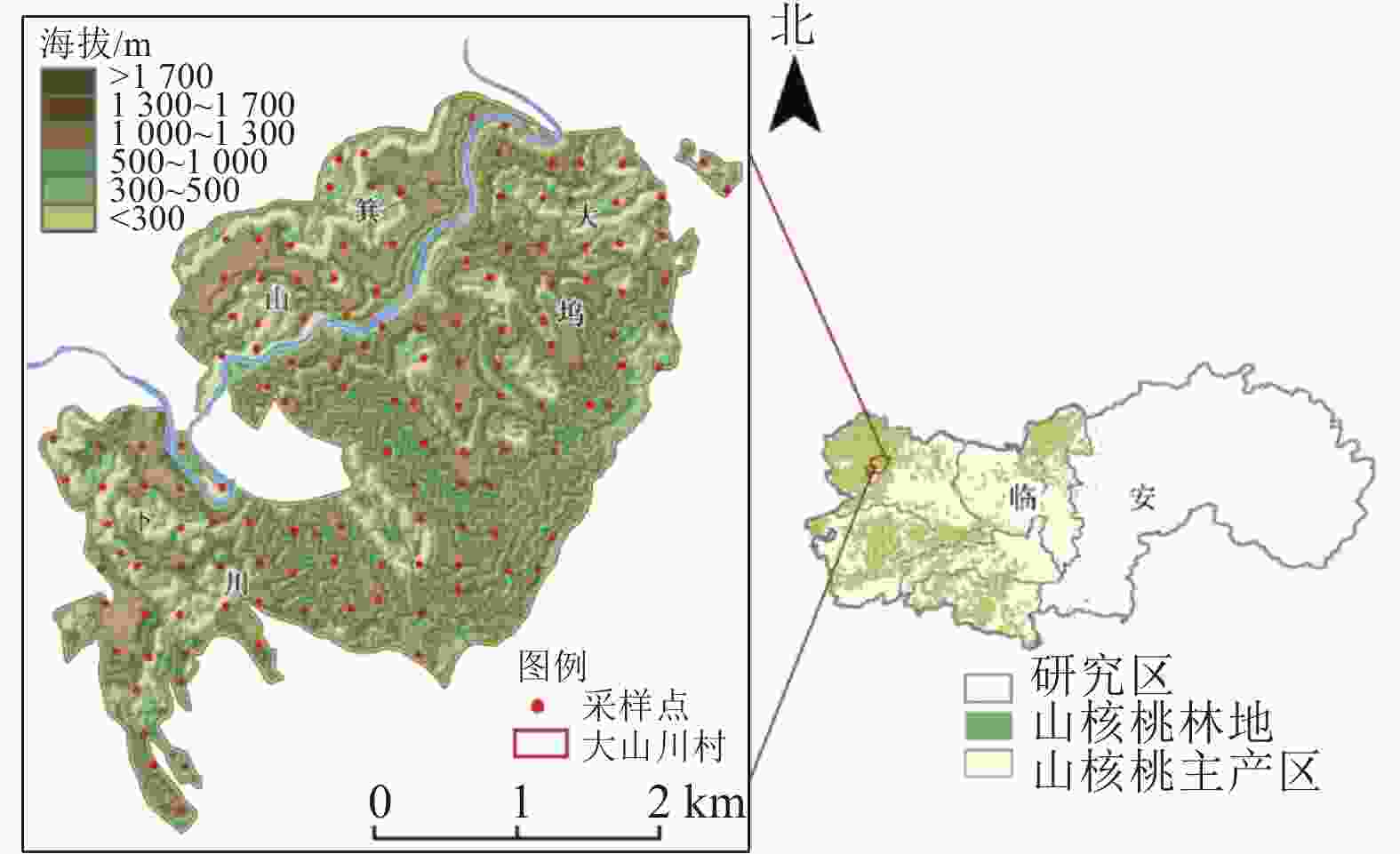
 下载:
下载:
